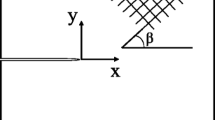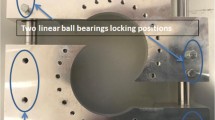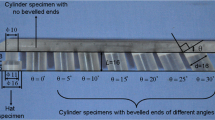Abstract
The use of losipescu specimens for the determination of the shear properties of a vinyl-ester resin was investigated. The antisymmetric four-point bend and the Adams and Walrath fixtures were studied for their suitability in loading these specimens. Photoelastic and strain-gage data in addition to published finite-element results show that the latter fixture distorts the stress field in the gage section. The antisymmetric four-point bend fixture is found to give the purest shear-stress field in the gage section and to yield the most reliable shear-modulus values. A refined photoelastic analysis shows that the shear-stress distribution between the notch roots is essentially uniform with a relative maximum or minimum at the centroid depending on the depths of the notches. Also, stress risers of up to 30 percent are observed near the notch roots. Except at the roots, finite-element predictions are presented which are in excellent agreement with photoelastic data. The failure mode of this vinyl-ester resin is tensile and the corresponding tensile stress calculated from the average shear stress in the gage section of the losipescu specimen is in excellent agreement with failure data acquired in tension.
Similar content being viewed by others
References
Whitney, J.M., Grimes, G.C. andFrancis, P.H., “Effects of End Attachment on the Strength of Fiber-reinforced Composite Cylinders,”Experimental Mechanics,13 (5),185 (May 1973).
Pagano, N.J. andWhitney, J.M., “Geometric Design of Composite Cylindrical Characterization Specimens,”J. Comp. Mat.,4,538 (1970).
Chamis, C.C. and Sinclair, J.H., “100 Off-Axis Tensile Test for Interlaminar Shear Characterization of Fiber Composites,” NASA Tech. Note No. NASA TN d-8215 (April 1976).
Rosen, B.W., “A Simple Procedure for Experimental Determination of the Longitudinal Shear Modulus of Unidirectional Composites,”J. Comp. Mat.,6,552 (1972).
Whitney, J.M., Stansbarger, D.L. andHowell, H.B., “Analysis of the Rail Shear Test — Applications and Limitations,”J. Comp. Mat.,5,24 (1971).
Sims, D.F., “In-Plane Shear Stress-Strain Response of Unidirectional Composite Materials,”J. Comp. Mat.,1,124 (1973).
Garcia, R., Weisshaar, T.A. andMcWithey, R.R., “An Experimental and Analytical Investigation of the Rail Shear-test Method as Applied to Composite Materials,”Experimental Mechanics,20 (8),273–279 (Aug. 1980).
Duggan, M.F., “An Experimental Evaluation of the Slotted-tension Shear Test for Composite Materials,”Experimental Mechanics,20 (7),233–239 (July 1980).
Voloshin, A. andArcan, M., “Failure of Unidirectional Fiberreinforced Materials—New Methodology and Results,”Experimental Mechanics,20 (8),280–284 (Aug. 1980).
Arcan, M., Hashin, Z. andVoloshin, A., “A Method to Produce Uniform Plane-stress States with Applications to Fiber-reinforced Materials,”Experimental Mechanics,18 (4),141–146 (April 1978).
Voloshin, A. andArcan, M., “Pure Shear Moduli of Unidirectional Fibre-reinforced Materials (FRM),”Fibre Sci. and Tech.,13,124 (1980).
Iosipescu, N., “New Accurate Method for Single Shear Testing of Metals,”J. Mat.,3,537 (1967).
Iosipescu, N., “Photoelastic Investigations on an Accurate Procedure for the Pure Shear Testing of Materials,”Rev. de Mec. Appl.,1,145 (1963).
Walrath, D.E. and Adams, D.F., “Static and Dynamic Shear Testing of SMC Composite Materials,” Rep. No. UWME-DR-004-103-1, Dept. of Mech. Eng., Univ. of Wyoming (March 1980).
Walrath, D.E. and Adams, D.F., “Shear Strength and Modulus of SMC-R50 and XMC-3 Composite Materials,” Rep. No. UWME-DR-004-105-1, Dept. of Mechanical Engineering, Univ. of Wyoming (May 1980).
Walrath, D.E. andAdams, D.F., “The Iosipescu Shear Test as Applied to Composite Materials,”Experimental Mechanics,23 (1),105–110 (March 1983).
“Elevated Temperature Iosipescu Shear Tests of SMC Materials,” General Motors Tech. Ctr., Warren, MI, Purchase Order No. MD-839422 (Jan. 1980).
Adams, D.F. and Walrath, D.E., “Iosipescu Shear Properties of SMC Composite Materials,” ASTM STP 789, 19–33 (1981).
Spilker, R.L., “A Hybrid-Stress Finite-Element Formulation for Thick Multilayer Laminates,”Computers and Structures,11,507 (1980).
Jessop, H.T. andHarris, F.C., “Photoelasticity, Principles and Methods,”Dover, NY, 103 (1949).
Walrath, D.E. and Adams, D.F., “Analysis of the Stress State in an Iosipescu Test Specimen,” Rep. No. UWME-DR-301-102-1, Dept. of Mech. Eng., Univ. of Wyoming (June 1983).
Herakovich, C.T. and Bergner, Jr., H.W., “Finite Element Stress Analysis of a Notched Coupon For In-Plane Shear Behavior of Composites,” Composites, 149 (1980).
Slepetz, J.M., Zagaeski, T.F. and Novello, R.F., “In-Plane Shear Test for Composite Materials,” Rep. No. AMMRC TR 78-30, Army materials and Mechanics Research Ctr. (July 1978).
Author information
Authors and Affiliations
Rights and permissions
About this article
Cite this article
Sullivan, J.L., Kao, B.G. & Van Oene, H. Shear properties and a stress analysis obtained from vinyl-ester losipescu specimens. Experimental Mechanics 24, 223–232 (1984). https://doi.org/10.1007/BF02323169
Received:
Revised:
Issue Date:
DOI: https://doi.org/10.1007/BF02323169




